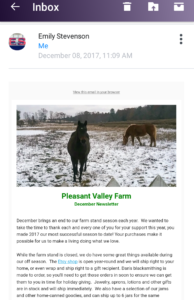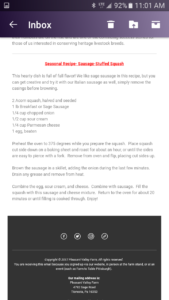Email newsletters are a great way to keep in touch with your customers and let them know what is in season on your homestead. It’s a great way to highlight new products, important dates (like first or last market days of the season) or share exciting news about what is going on at your homestead or small farm.
For years I would create the newsletter as a file and attach it to an email, but these days it’s easy to create an engaging newsletter full of photos and links that can be viewed directly from a recipient’s inbox and look great on smartphone screens, too. I use Mailchimp. It automates much of the process, enabling me to store my list of emails securely and use a variety of templates to make attractive emails. Depending on your needs, you can sign up for a free account and send emails, which is what I do. You can also sign up for a paid account to unlock more features or send a larger number of emails per month, but so far I have not found that to be necessary. Similar sites exist, but Mailchimp is the only one I have personally used. It has a variety of templates and is drag and drop, so you don’t need to be a computer whiz to crate something that looks professional. It also automates an unsubscribe feature which makes it easier to keep your list of recipients up to date.

It’s a good idea to make sure your newsletter is easy to read on a phone as well as a computer!
To get newsletter subscribers, you have a number of options. The simplest is a paper form at your farm stand or farmer’s market table. We have had great success with this low-tech method. We also have a sign-up form on our website. Since I can’t talk to them in person like at the farm stand, I have fields for name, email, town, a drop-down box telling me how they found us, and a box for them to comment or let us know what they are interested in hearing about. This form works well for us, but could certainly be as simple as name and email address only. Sharing your newsletter on social media sites and offering a way to sign up (by direct message of their email address, for example) is a third great way to get subscribers.
I used to struggle with content for the newsletter. After a few years, I felt I was repeating myself. But after talking to customers, I found they actually appreciated a degree of repetition form year to year. They enjoyed spring photos of chicks and bunnies, and looked forward to the email announcing the year’s variety of heirloom tomatoes. Asking my customers what they enjoyed reading, and having a space on the sign-up form that allows new subscribers to tell me what they want to read has helped greatly.

Recipes are always popular with our customers. This fall recipe features our homemade sausage as well as squash and eggs they can buy from our farm.
The most requested feature has been recipes. I try to include a seasonal recipe featuring a vegetable we will have on hand, a cut of meat we offer, or both. Many folks are not used to cooking with whole ingredients, so it’s helpful to give them a blueprint of how to make a meal with items we offer. Offering a recipe is a great way to encourage people to try something new. This may be a vegetable you are growing for the first time or a less popular cut of meat. Spotlighting something can help to boost its sales, so it’s worth considering what you are overstocked with and offer a recipe that includes it!
The most frequently commented on features are the ones about our animals. When I came to the farm and learned about endangered breeds of livestock, I was shocked. Shocked that something that seemed common was more complicated. And shocked that as an educated adult with two college degrees, this was an issue I’d never even heard of- and people can’t care about what they don’t know about! I profile one of our heritage breeds most months, highlighting a few facts about what makes the breed special, where it comes from, and why it’s a good fit for our small farm. We currently raise a dozen species of livestock and poultry, and have more than one breed of some kinds of the birds, so it makes it easy for me to keep this a running feature. I profile any new breed that comes to the farm. It makes sense to talk about why Delaware chickens are special if you are hatching chicks for sale, or about Katahdin sheep if you are offering pasture-raised lamb chops. Not only do these features increase interest when you have stock for sale, but it also helps give customers a deeper connection to food or fiber products that come from these breeds.
I’ve found by having a template I can make writing a newsletter easier. I feature an opening section featuring what is new, coming into season, or on sale. A recipe featuring seasonal ingredients, using a number available at the farm. A short article on one of the heritage breeds we raise or an individual animal. A bar of links to our Facebook, Instagram, website, email, Homestead Hustle blog, and Etsy store. I also have the flexibility to add another short article if something else exciting is going on. One well-crafted email can reach hundreds or even thousands of customers and is a great way to feature your products and increase sales.










